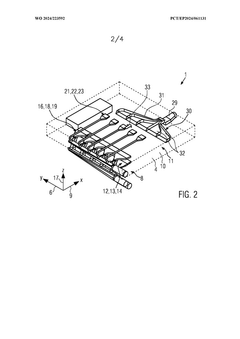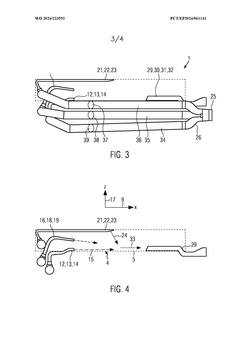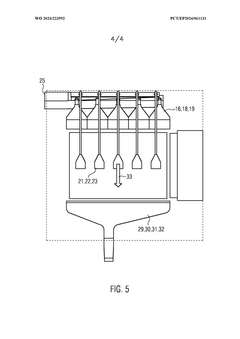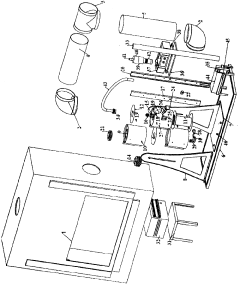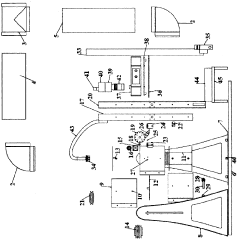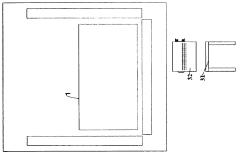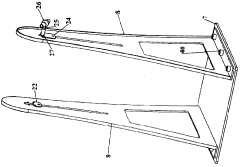How Laminar Flow Supports Advanced Manufacturing Techniques?
JUL 10, 20259 MIN READ
Generate Your Research Report Instantly with AI Agent
Patsnap Eureka helps you evaluate technical feasibility & market potential.
Laminar Flow in Manufacturing: Background and Objectives
Laminar flow, characterized by smooth and predictable fluid motion, has become a cornerstone in advanced manufacturing techniques. This phenomenon, first described by Osborne Reynolds in the late 19th century, has evolved from a theoretical concept to a practical tool in modern industrial processes. The historical progression of laminar flow applications in manufacturing reflects the broader trends in technological advancement and precision engineering.
In recent decades, the integration of laminar flow principles into manufacturing has accelerated, driven by the increasing demand for high-precision components in industries such as aerospace, electronics, and medical devices. The controlled environment provided by laminar flow has proven crucial in minimizing contamination and ensuring consistent product quality. This has led to the development of specialized clean rooms and laminar flow cabinets, which have become standard in many high-tech manufacturing facilities.
The objectives of utilizing laminar flow in advanced manufacturing are multifaceted. Primarily, it aims to enhance product quality by reducing particulate contamination and ensuring uniform processing conditions. This is particularly critical in the production of sensitive electronic components, where even microscopic impurities can lead to device failure. Additionally, laminar flow supports the creation of more precise and complex geometries in additive manufacturing processes, enabling the production of components with previously unattainable features.
Another key objective is to improve process efficiency and repeatability. By maintaining consistent flow patterns, manufacturers can achieve more predictable outcomes, reduce waste, and optimize material usage. This is especially relevant in chemical processing and coating applications, where uniform distribution of reactants or coatings is essential for product performance.
The evolution of laminar flow applications has been closely tied to advancements in computational fluid dynamics (CFD) and simulation technologies. These tools have allowed engineers to model and optimize flow patterns with unprecedented accuracy, leading to more sophisticated manufacturing systems. The integration of real-time monitoring and control systems has further enhanced the ability to maintain laminar flow conditions in dynamic manufacturing environments.
Looking forward, the role of laminar flow in advanced manufacturing is expected to expand. Emerging technologies such as 3D bioprinting and nanostructure fabrication are pushing the boundaries of what's possible with controlled fluid dynamics. The ongoing research into microfluidics and lab-on-a-chip technologies promises to open new frontiers in miniaturized manufacturing processes, where laminar flow principles are fundamental to success.
In recent decades, the integration of laminar flow principles into manufacturing has accelerated, driven by the increasing demand for high-precision components in industries such as aerospace, electronics, and medical devices. The controlled environment provided by laminar flow has proven crucial in minimizing contamination and ensuring consistent product quality. This has led to the development of specialized clean rooms and laminar flow cabinets, which have become standard in many high-tech manufacturing facilities.
The objectives of utilizing laminar flow in advanced manufacturing are multifaceted. Primarily, it aims to enhance product quality by reducing particulate contamination and ensuring uniform processing conditions. This is particularly critical in the production of sensitive electronic components, where even microscopic impurities can lead to device failure. Additionally, laminar flow supports the creation of more precise and complex geometries in additive manufacturing processes, enabling the production of components with previously unattainable features.
Another key objective is to improve process efficiency and repeatability. By maintaining consistent flow patterns, manufacturers can achieve more predictable outcomes, reduce waste, and optimize material usage. This is especially relevant in chemical processing and coating applications, where uniform distribution of reactants or coatings is essential for product performance.
The evolution of laminar flow applications has been closely tied to advancements in computational fluid dynamics (CFD) and simulation technologies. These tools have allowed engineers to model and optimize flow patterns with unprecedented accuracy, leading to more sophisticated manufacturing systems. The integration of real-time monitoring and control systems has further enhanced the ability to maintain laminar flow conditions in dynamic manufacturing environments.
Looking forward, the role of laminar flow in advanced manufacturing is expected to expand. Emerging technologies such as 3D bioprinting and nanostructure fabrication are pushing the boundaries of what's possible with controlled fluid dynamics. The ongoing research into microfluidics and lab-on-a-chip technologies promises to open new frontiers in miniaturized manufacturing processes, where laminar flow principles are fundamental to success.
Market Demand for Precision Manufacturing Solutions
The demand for precision manufacturing solutions has been steadily increasing across various industries, driven by the need for higher quality products, improved efficiency, and reduced waste. Laminar flow technology plays a crucial role in meeting these demands by providing a controlled environment for advanced manufacturing processes.
In the semiconductor industry, the market for precision manufacturing solutions is particularly robust. As chip manufacturers strive to produce smaller, more powerful, and energy-efficient devices, the need for ultra-clean environments and precise control over manufacturing processes becomes paramount. Laminar flow systems are essential in cleanrooms, ensuring that airborne particles do not interfere with the delicate fabrication processes of microchips and other electronic components.
The aerospace and automotive sectors also demonstrate a growing demand for precision manufacturing solutions incorporating laminar flow technology. These industries require components with extremely tight tolerances and superior surface finishes. Laminar flow supports advanced techniques such as additive manufacturing and high-precision machining by maintaining a stable, contaminant-free environment that enhances the accuracy and repeatability of these processes.
In the medical device and pharmaceutical industries, the market for precision manufacturing solutions is expanding rapidly. The production of implants, drug delivery systems, and diagnostic equipment demands stringent quality control and sterile manufacturing conditions. Laminar flow systems are critical in maintaining the required cleanliness levels and preventing contamination during the production of these sensitive medical products.
The optical industry, including manufacturers of lenses, mirrors, and other precision optical components, relies heavily on laminar flow technology to achieve the necessary surface quality and dimensional accuracy. The market for high-performance optical devices in fields such as astronomy, laser technology, and advanced imaging systems continues to drive demand for precision manufacturing solutions.
As industries move towards Industry 4.0 and smart manufacturing, the integration of laminar flow technology with advanced sensors and control systems is creating new market opportunities. These integrated solutions offer real-time monitoring and adjustment of manufacturing environments, further enhancing precision and consistency in production processes.
The global market for cleanroom technology, which includes laminar flow systems, is projected to grow significantly in the coming years. This growth is fueled by the increasing adoption of advanced manufacturing techniques across various sectors and the stringent regulatory requirements for product quality and safety in industries such as pharmaceuticals and electronics.
In the semiconductor industry, the market for precision manufacturing solutions is particularly robust. As chip manufacturers strive to produce smaller, more powerful, and energy-efficient devices, the need for ultra-clean environments and precise control over manufacturing processes becomes paramount. Laminar flow systems are essential in cleanrooms, ensuring that airborne particles do not interfere with the delicate fabrication processes of microchips and other electronic components.
The aerospace and automotive sectors also demonstrate a growing demand for precision manufacturing solutions incorporating laminar flow technology. These industries require components with extremely tight tolerances and superior surface finishes. Laminar flow supports advanced techniques such as additive manufacturing and high-precision machining by maintaining a stable, contaminant-free environment that enhances the accuracy and repeatability of these processes.
In the medical device and pharmaceutical industries, the market for precision manufacturing solutions is expanding rapidly. The production of implants, drug delivery systems, and diagnostic equipment demands stringent quality control and sterile manufacturing conditions. Laminar flow systems are critical in maintaining the required cleanliness levels and preventing contamination during the production of these sensitive medical products.
The optical industry, including manufacturers of lenses, mirrors, and other precision optical components, relies heavily on laminar flow technology to achieve the necessary surface quality and dimensional accuracy. The market for high-performance optical devices in fields such as astronomy, laser technology, and advanced imaging systems continues to drive demand for precision manufacturing solutions.
As industries move towards Industry 4.0 and smart manufacturing, the integration of laminar flow technology with advanced sensors and control systems is creating new market opportunities. These integrated solutions offer real-time monitoring and adjustment of manufacturing environments, further enhancing precision and consistency in production processes.
The global market for cleanroom technology, which includes laminar flow systems, is projected to grow significantly in the coming years. This growth is fueled by the increasing adoption of advanced manufacturing techniques across various sectors and the stringent regulatory requirements for product quality and safety in industries such as pharmaceuticals and electronics.
Current State and Challenges in Laminar Flow Technology
Laminar flow technology has made significant strides in recent years, particularly in its application to advanced manufacturing techniques. The current state of laminar flow technology is characterized by its widespread use in various industries, including aerospace, automotive, and medical device manufacturing. This controlled airflow system has become an integral part of clean room environments, ensuring the production of high-precision components and contamination-free products.
One of the primary challenges facing laminar flow technology is the maintenance of consistent airflow patterns across large areas. As manufacturing processes become more complex and require larger clean room spaces, ensuring uniform laminar flow becomes increasingly difficult. Engineers are working on developing more sophisticated air handling systems and computational fluid dynamics models to address this issue.
Another significant challenge is the energy efficiency of laminar flow systems. The continuous operation of these systems requires substantial energy input, which can lead to high operational costs and environmental concerns. Researchers are exploring ways to optimize airflow patterns and reduce energy consumption without compromising the cleanliness and precision of the manufacturing environment.
The integration of laminar flow technology with advanced manufacturing techniques, such as 3D printing and nanofabrication, presents both opportunities and challenges. While laminar flow can significantly enhance the quality and consistency of these processes, it also requires careful calibration and adaptation to work effectively with new manufacturing methods.
Contamination control remains a critical challenge in laminar flow applications. As manufacturing tolerances become tighter and product specifications more demanding, even minute particles can cause significant issues. Developing more effective filtration systems and monitoring technologies is crucial to maintaining the ultra-clean environments required for cutting-edge manufacturing.
The scalability of laminar flow technology is another area of focus. As industries move towards larger-scale production of high-precision components, there is a need for laminar flow solutions that can be effectively implemented in larger facilities without compromising performance or efficiency.
Lastly, the adaptation of laminar flow technology to flexible manufacturing environments poses a significant challenge. As industries increasingly require adaptable production lines, developing laminar flow systems that can be quickly reconfigured or adjusted to accommodate different manufacturing processes is becoming essential.
One of the primary challenges facing laminar flow technology is the maintenance of consistent airflow patterns across large areas. As manufacturing processes become more complex and require larger clean room spaces, ensuring uniform laminar flow becomes increasingly difficult. Engineers are working on developing more sophisticated air handling systems and computational fluid dynamics models to address this issue.
Another significant challenge is the energy efficiency of laminar flow systems. The continuous operation of these systems requires substantial energy input, which can lead to high operational costs and environmental concerns. Researchers are exploring ways to optimize airflow patterns and reduce energy consumption without compromising the cleanliness and precision of the manufacturing environment.
The integration of laminar flow technology with advanced manufacturing techniques, such as 3D printing and nanofabrication, presents both opportunities and challenges. While laminar flow can significantly enhance the quality and consistency of these processes, it also requires careful calibration and adaptation to work effectively with new manufacturing methods.
Contamination control remains a critical challenge in laminar flow applications. As manufacturing tolerances become tighter and product specifications more demanding, even minute particles can cause significant issues. Developing more effective filtration systems and monitoring technologies is crucial to maintaining the ultra-clean environments required for cutting-edge manufacturing.
The scalability of laminar flow technology is another area of focus. As industries move towards larger-scale production of high-precision components, there is a need for laminar flow solutions that can be effectively implemented in larger facilities without compromising performance or efficiency.
Lastly, the adaptation of laminar flow technology to flexible manufacturing environments poses a significant challenge. As industries increasingly require adaptable production lines, developing laminar flow systems that can be quickly reconfigured or adjusted to accommodate different manufacturing processes is becoming essential.
Existing Laminar Flow Solutions in Manufacturing Processes
01 Laminar flow measurement and control systems
Various systems and methods for measuring and controlling laminar flow in different applications. These include optical systems for detecting flow characteristics, flow control devices for maintaining laminar flow conditions, and sensors for monitoring flow parameters in real-time.- Laminar flow measurement and control systems: Various systems and methods for measuring and controlling laminar flow in different applications. These include optical systems for detecting flow characteristics, flow meters for precise measurements, and control mechanisms to maintain laminar flow conditions in fluid systems.
- Laminar flow in air distribution and ventilation: Techniques for creating and maintaining laminar airflow in ventilation systems, clean rooms, and air distribution units. This includes designs for air outlets, flow straighteners, and systems to reduce turbulence in air handling equipment.
- Laminar flow in fluid handling and processing: Applications of laminar flow principles in fluid handling equipment, including pumps, valves, and fluid processing systems. This covers designs for maintaining laminar flow in pipes, channels, and vessels to improve efficiency and reduce turbulence.
- Laminar flow in medical and laboratory devices: Utilization of laminar flow in medical equipment and laboratory instruments. This includes designs for biosafety cabinets, cell culture systems, and analytical devices that require precise control of fluid or air flow to maintain sterile conditions or accurate measurements.
- Laminar flow in industrial processes and manufacturing: Implementation of laminar flow principles in industrial processes and manufacturing equipment. This covers applications in coating systems, material handling, and production line designs where controlled, non-turbulent flow is critical for product quality and process efficiency.
02 Laminar flow in fluid handling equipment
Designs and techniques for achieving laminar flow in fluid handling equipment such as pumps, valves, and nozzles. This includes specialized geometries, surface treatments, and flow path designs to promote and maintain laminar flow conditions in various industrial and scientific applications.Expand Specific Solutions03 Laminar flow in aerodynamics and vehicle design
Applications of laminar flow principles in aerodynamics and vehicle design to reduce drag and improve efficiency. This includes techniques for maintaining laminar flow over surfaces, boundary layer control methods, and design features that promote laminar flow conditions.Expand Specific Solutions04 Laminar flow in medical and pharmaceutical applications
Utilization of laminar flow principles in medical and pharmaceutical settings, including clean room technologies, drug delivery systems, and medical devices. This involves creating controlled environments, precise fluid handling, and contamination prevention through laminar flow techniques.Expand Specific Solutions05 Laminar flow in environmental and energy applications
Implementation of laminar flow concepts in environmental monitoring, energy production, and resource management. This includes applications in air and water quality monitoring, renewable energy systems, and efficient resource extraction techniques that rely on laminar flow properties.Expand Specific Solutions
Key Players in Laminar Flow and Advanced Manufacturing
The competitive landscape for laminar flow in advanced manufacturing is characterized by a mature market with established players and ongoing technological advancements. The market size is substantial, driven by aerospace, automotive, and semiconductor industries' demand for precision manufacturing. Companies like Boeing, Airbus, and TSMC are at the forefront, leveraging laminar flow technology to enhance production processes. The technology's maturity is evident in its widespread adoption, with firms like Ichor Systems and Picosun Oy providing specialized equipment. However, there's still room for innovation, as seen in the research efforts of institutions like Brigham Young University and the National Institute of Advanced Industrial Science and Technology, indicating potential for further market growth and technological refinement.
The Boeing Co.
Technical Solution: Boeing has developed advanced laminar flow control (LFC) technologies for aircraft manufacturing. Their approach involves integrating LFC systems into wing designs, utilizing micro-perforated surfaces and suction systems to maintain laminar flow over larger portions of the wing[1]. This technology reduces drag by up to 15%, leading to significant fuel efficiency improvements[2]. Boeing's manufacturing techniques also incorporate computational fluid dynamics (CFD) simulations to optimize airfoil shapes and surface treatments, ensuring maximum laminar flow benefit across various flight conditions[3].
Strengths: Significant drag reduction, improved fuel efficiency, and extensive experience in aerospace applications. Weaknesses: High implementation costs and potential maintenance complexities in real-world operations.
Airbus Espana SL
Technical Solution: Airbus Espana has pioneered the use of laminar flow in advanced manufacturing through its BLADE (Breakthrough Laminar Aircraft Demonstrator in Europe) project. This initiative focuses on developing and testing Natural Laminar Flow (NLF) wing sections on an A340 testbed aircraft[4]. The manufacturing process involves creating ultra-smooth wing surfaces using advanced composite materials and precision milling techniques. Airbus has also implemented innovative surface coating technologies to maintain laminar flow under various atmospheric conditions[5]. Their approach includes the use of smart sensors and real-time monitoring systems to assess laminar flow performance during flight, allowing for continuous optimization of manufacturing processes[6].
Strengths: Proven real-world testing, integration of smart technologies, and potential for significant fuel savings. Weaknesses: Complexity in scaling up to full production models and sensitivity to surface contamination.
Core Innovations in Laminar Flow Control Systems
Device and method for the directed application of gas to a build space for additive manufacturing
PatentWO2024223592A1
Innovation
- A device with a unique nozzle configuration that generates a laminar gas flow by combining horizontal and vertical gas streams, ensuring a uniform and efficient gas distribution over the construction platform, reducing turbulence and enhancing energy input during the manufacturing process.
Device for generating laminar flow implemented in a tubular furnace.
PatentActiveMX2017015541A
Innovation
- A laminar flow emitter device is integrated into a tubular oven with a piezoelectric system operating at 0.8 MHz to generate aerosols, surrounded by four cylindrical ducts that maintain laminar flow and prevent turbulence, allowing for both horizontal and vertical orientations, with independently controlled gas flows to enhance aerosol delivery.
Environmental Impact of Laminar Flow Technologies
Laminar flow technologies, while primarily associated with advanced manufacturing techniques, also have significant environmental implications. The controlled and predictable nature of laminar flow systems contributes to more efficient and cleaner manufacturing processes, which in turn can lead to reduced environmental impact.
One of the key environmental benefits of laminar flow technologies is the reduction in energy consumption. By minimizing turbulence and maintaining a steady, predictable flow of air or fluids, these systems require less energy to operate compared to their turbulent counterparts. This energy efficiency translates directly into lower greenhouse gas emissions and a smaller carbon footprint for manufacturing facilities employing laminar flow techniques.
Furthermore, laminar flow technologies often result in improved precision and reduced waste in manufacturing processes. The controlled environment created by laminar flow systems allows for more accurate deposition of materials, more precise cutting and shaping, and overall higher quality outputs. This increased precision leads to fewer defects and less material waste, ultimately reducing the environmental impact associated with raw material extraction and disposal of rejected products.
In cleanroom environments, laminar flow systems play a crucial role in maintaining air quality and preventing contamination. This not only ensures product quality but also minimizes the release of potentially harmful particles into the broader environment. By containing and filtering air within the manufacturing space, these systems help prevent the spread of pollutants and particulates that could otherwise be released into the atmosphere.
The use of laminar flow in liquid handling and chemical processes also contributes to environmental protection. By providing precise control over fluid movements, these technologies can reduce the risk of spills and leaks, thereby minimizing the potential for environmental contamination. This is particularly important in industries dealing with hazardous materials or sensitive chemical processes.
Additionally, laminar flow technologies often enable more compact and efficient manufacturing setups. This can lead to smaller factory footprints, reduced land use, and more efficient use of resources. The ability to create controlled environments in smaller spaces also opens up possibilities for localized, distributed manufacturing, potentially reducing transportation-related emissions in supply chains.
However, it is important to note that the environmental benefits of laminar flow technologies must be balanced against the resources required to implement and maintain these systems. The production of specialized equipment and the energy needed to operate continuous air or fluid flow systems should be considered in a comprehensive environmental assessment. Nonetheless, when properly implemented, the overall environmental impact of laminar flow technologies in advanced manufacturing is generally positive, contributing to more sustainable industrial practices.
One of the key environmental benefits of laminar flow technologies is the reduction in energy consumption. By minimizing turbulence and maintaining a steady, predictable flow of air or fluids, these systems require less energy to operate compared to their turbulent counterparts. This energy efficiency translates directly into lower greenhouse gas emissions and a smaller carbon footprint for manufacturing facilities employing laminar flow techniques.
Furthermore, laminar flow technologies often result in improved precision and reduced waste in manufacturing processes. The controlled environment created by laminar flow systems allows for more accurate deposition of materials, more precise cutting and shaping, and overall higher quality outputs. This increased precision leads to fewer defects and less material waste, ultimately reducing the environmental impact associated with raw material extraction and disposal of rejected products.
In cleanroom environments, laminar flow systems play a crucial role in maintaining air quality and preventing contamination. This not only ensures product quality but also minimizes the release of potentially harmful particles into the broader environment. By containing and filtering air within the manufacturing space, these systems help prevent the spread of pollutants and particulates that could otherwise be released into the atmosphere.
The use of laminar flow in liquid handling and chemical processes also contributes to environmental protection. By providing precise control over fluid movements, these technologies can reduce the risk of spills and leaks, thereby minimizing the potential for environmental contamination. This is particularly important in industries dealing with hazardous materials or sensitive chemical processes.
Additionally, laminar flow technologies often enable more compact and efficient manufacturing setups. This can lead to smaller factory footprints, reduced land use, and more efficient use of resources. The ability to create controlled environments in smaller spaces also opens up possibilities for localized, distributed manufacturing, potentially reducing transportation-related emissions in supply chains.
However, it is important to note that the environmental benefits of laminar flow technologies must be balanced against the resources required to implement and maintain these systems. The production of specialized equipment and the energy needed to operate continuous air or fluid flow systems should be considered in a comprehensive environmental assessment. Nonetheless, when properly implemented, the overall environmental impact of laminar flow technologies in advanced manufacturing is generally positive, contributing to more sustainable industrial practices.
Cost-Benefit Analysis of Implementing Laminar Flow Systems
Implementing laminar flow systems in advanced manufacturing processes requires a thorough cost-benefit analysis to determine their economic viability. The initial investment in laminar flow technology can be substantial, encompassing equipment costs, facility modifications, and staff training. High-grade HEPA filters, specialized air handling units, and precise control systems contribute significantly to the upfront expenses. Additionally, retrofitting existing manufacturing spaces to accommodate laminar flow conditions may involve extensive renovations, potentially leading to temporary production disruptions.
However, the long-term benefits of laminar flow systems often outweigh these initial costs. One of the primary advantages is the dramatic reduction in contamination-related defects, which can lead to substantial savings in material waste and rework expenses. In industries such as semiconductor manufacturing or pharmaceutical production, where even microscopic contaminants can render entire batches unusable, the impact on yield improvement can be particularly pronounced.
Operational efficiency gains represent another significant benefit. Laminar flow environments enable more consistent and predictable manufacturing conditions, potentially increasing throughput and reducing cycle times. This improved efficiency can translate into higher production volumes and better utilization of equipment and personnel resources.
Energy consumption is a critical factor to consider in the cost-benefit equation. While laminar flow systems require continuous operation of air handling equipment, advancements in energy-efficient technologies have helped mitigate these ongoing expenses. The implementation of variable speed drives and intelligent control systems can optimize energy usage based on real-time production needs.
Quality assurance and regulatory compliance benefits should not be overlooked. Laminar flow systems can significantly enhance a company's ability to meet stringent industry standards and regulatory requirements. This can lead to reduced quality control costs, fewer product recalls, and improved market reputation, all of which contribute positively to the overall financial picture.
The analysis should also account for potential improvements in worker health and safety. By creating a cleaner working environment, laminar flow systems may reduce employee exposure to harmful particles or chemicals, potentially lowering healthcare costs and improving workforce productivity.
When evaluating the return on investment, it's crucial to consider the lifecycle of the laminar flow system. While the initial costs may be high, the longevity of well-maintained systems and their positive impact on product quality and operational efficiency can result in a favorable long-term financial outcome. Companies must also factor in the potential for increased market share and premium pricing that may result from the ability to produce higher-quality products consistently.
However, the long-term benefits of laminar flow systems often outweigh these initial costs. One of the primary advantages is the dramatic reduction in contamination-related defects, which can lead to substantial savings in material waste and rework expenses. In industries such as semiconductor manufacturing or pharmaceutical production, where even microscopic contaminants can render entire batches unusable, the impact on yield improvement can be particularly pronounced.
Operational efficiency gains represent another significant benefit. Laminar flow environments enable more consistent and predictable manufacturing conditions, potentially increasing throughput and reducing cycle times. This improved efficiency can translate into higher production volumes and better utilization of equipment and personnel resources.
Energy consumption is a critical factor to consider in the cost-benefit equation. While laminar flow systems require continuous operation of air handling equipment, advancements in energy-efficient technologies have helped mitigate these ongoing expenses. The implementation of variable speed drives and intelligent control systems can optimize energy usage based on real-time production needs.
Quality assurance and regulatory compliance benefits should not be overlooked. Laminar flow systems can significantly enhance a company's ability to meet stringent industry standards and regulatory requirements. This can lead to reduced quality control costs, fewer product recalls, and improved market reputation, all of which contribute positively to the overall financial picture.
The analysis should also account for potential improvements in worker health and safety. By creating a cleaner working environment, laminar flow systems may reduce employee exposure to harmful particles or chemicals, potentially lowering healthcare costs and improving workforce productivity.
When evaluating the return on investment, it's crucial to consider the lifecycle of the laminar flow system. While the initial costs may be high, the longevity of well-maintained systems and their positive impact on product quality and operational efficiency can result in a favorable long-term financial outcome. Companies must also factor in the potential for increased market share and premium pricing that may result from the ability to produce higher-quality products consistently.
Unlock deeper insights with Patsnap Eureka Quick Research — get a full tech report to explore trends and direct your research. Try now!
Generate Your Research Report Instantly with AI Agent
Supercharge your innovation with Patsnap Eureka AI Agent Platform!

